Working between two different languages is always a challenge. To ensure your message gets across, it’s usually a good idea to seek help from a professional. But which service do you need: translation, transliteration, or transcription? The answer lies in what you want to achieve, and what type of content you are trying to convert. All three terms are related, but each means something slightly different. Trying to choose the right option for your business can be a little confusing — which is why we decided to take a closer look at this topic.
What Are Translation, Transliteration, and Transcription?
It’s very rare for any business to succeed in a foreign market without adapting to the local language. Even if your budget cannot stretch to full localization, you can still make your website and marketing content more accessible. In order to achieve this, you’re probably going to need to use a specialist solution. But before you start deciding on a service, it’s important to understand the many ways in which you can approach this challenge. Let’s start with some basic introductions of three common techniques.
What Is Translation?
Translation is the act of converting written content from a source language to a target language. Ideally, the resulting content should precisely match the original meaning — just using a different native tongue. There are essentially two different ways to complete this process: with machine translation or professional translation. Machine translation (MT) is where smart software provides an instant translation. MT is not always completely accurate, but it’s very affordable. Professional translation is where a human completes the task, usually with the help of a translation memory tool. This takes longer than any automated translation solution, but the results are usually much more accurate.
What Is Transliteration?
Transliteration is the process of converting written content into a different alphabet or script, character by character. Most native English speakers would struggle to guess the pronunciation of words written in the Arabic script or the Greek alphabet. But after transliteration, it’s at least possible to read and maybe even pronounce a given word. The purpose of this process is to make foreign content a little more accessible. There are many transliteration solutions to choose from nowadays, most of them automated. As with machine translation, they are fast and affordable — but professional transliteration is likely to produce better quality.
What Is Transcription?
In most cases, transcription is the process of recording spoken words using written characters. Both the source material and resulting content are always in the same language. However, the term “transcription” is sometimes used as shorthand for “foreign language transcription". This is a different process, where words spoken in one language are reproduced in writing using a different language from the source material. Sometimes, that requires a change of script, as well. No matter whether the source material is audio or textual, the transcription process can be completed either with an automated tool or by a professional transcriber. The comparison between the two will feel familiar: machine transcription is cheaper and faster, but human transcription is more accurate. The difference in terms of accuracy is even greater for foreign language transcription.
Translation vs Transliteration vs Transcription: What Are the Main Differences?
As we have learned, these three terms all involve converting the written or spoken word in some way. But when you dig a little deeper, you soon start to see some major differences.
Translation vs Transliteration
Let’s start with an easy one. The distinction between translation and transliteration is actually quite clear. The sole purpose of translation is to carry the meaning of words from one language to another. In contrast, transliteration does not carry across any of the meaning between languages. It focuses entirely on the characters that make up each word. If you want someone who speaks a different language to understand your words, translation is the service you need. If you are only interested in making your words more readable for people who use different scripts, you can use transliteration.
Transliteration vs Transcription
The divide between transliteration and transcription is much smaller. In some cases, there is even some overlap between the two. Transliteration is about converting written characters into a different script. Transcription is about reproducing spoken words in writing. So far, so clear. However, foreign language transcription takes words spoken in one language and transfers them into a different written language, and sometimes a different script. This is where things start to get a little more confusing! The easiest way to decipher this riddle is with an example. Imagine a business leader delivered a keynote in English, and wanted to make his words more accessible. In particular, he wants to connect with a Russian audience.
- With transliteration, the written script of his speech would be changed into the Cyrillic alphabet. The words would still be in English, but they would be easier to read for speakers of Russian and related languages.
- With transcription, he would get a written copy in English of the exact words he spoke. This could potentially be translated at a later date.
- With foreign language transcription, he would receive an exact written copy of his speech, but in Russian. This would require a change from Latin to Cyrillic script along the way.
Translation vs Transcription
Now we have cleared up that headache, we can return to something more straightforward. It’s quite clear that translation and transcription are very different ideas. Translation carries ideas from one language to another, while transcription only records what was said. If we’re talking about foreign language transcription, the same applies — the only difference is that the spoken content is reproduced in a different language. Another notable difference is that translation is perhaps more commonly applied to written content. In contrast, transcription only draws from speech. (Not sure how translation differs from interpretation? Check out our explainer here.
Translation, Transliteration, and Transcription: Which Do You Need?
These examples provide a glimpse of how translation, transliteration, and transcription can be useful in real-world scenarios. However, there are many more use cases to consider. If your aim is to make your content as accessible as possible, translation is the service you need. Most of us only engage with content and make purchases in our native language. Translation helps you reach out to people with a different mother tongue. Translation is used extensively for adapting content in software, mobile apps, games, websites, and technical documentation for different regions. You can also find examples of translation in business, law, finance, medicine, and any kind of online commerce. In other words, translation is useful whenever it’s important that both parties have a clear understanding. In comparison, the uses for transliteration are relatively narrow. The most common purpose is adapting names, so that they are easier to read and pronounce for non-native speakers. This could be a person’s name, a place name, the name of an event, or even a brand name. Product names sometimes get this treatment during localization. In the purest sense, transcription is only used for recording spoken words. So, every secretary who writes down the minutes of a meeting is performing transcription. Foreign language transcription is useful when you want those minutes to be readable in other languages. Examples might include presentations, online videos, and podcasts.
Why You Might Need a Translation Management System
If you decide that translation is the service you need, you should definitely consider using a translation management system, or TMS. Just like WordPress helps you publish blog posts, a good TMS can help you create and manage translations. The system will track every edit, and some systems can even import content automatically. Want to give it a try? Send us a message today.





